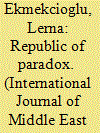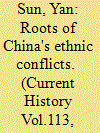| Srl | Item |
| 1 |
ID:
134628


|
|
|
|
|
| Summary/Abstract |
This article focuses on the years after World War I, especially the first decade following the 1923 establishment of the Republic of Turkey, in order to analyze the position of minorities in the developing “we” of the new nation as projected by its political elite. Situating the discussion in the context of the League of Nations interwar minority protection regime, I demonstrate that the Treaty of Lausanne, which the Ankara government and the Allies signed in July 1923, played an important role in the conflicting treatment that minorities have since received in Turkey. The treaty's minority protection clauses entrenched divisions that had already been formed in the Ottoman Empire during the violence of the preceding decade, including the Armenian genocide. Moreover, reminding Turkish leaders of how 19th-century European imperial powers had used the cause of Ottoman Christians’ suffering as an excuse to infringe on Ottoman sovereignty, these clauses alarmed the Turkish political elite, especially as the “Great Powers” themselves were not bound by such minority protection guarantees. The goal of preventing a repetition of this unbalanced international power dynamic, which, according to the new Turkey's leaders, had led to the demise of the Ottoman Empire, engendered paradoxical policies toward non-Muslim Turkish citizens; they have been largely excluded from a Turkness (Türklük) to which they were sometimes included, even forcibly included.
|
|
|
|
|
|
|
|
|
|
|
|
|
|
|
|
| 2 |
ID:
134001


|
|
|
|
|
| Publication |
2014.
|
| Summary/Abstract |
A surge of ethnic violence in China in recent years has revealed growing social tensions in a country beset by developmental strains, with a political system lagging behind epic economic change. In the first half of 2014 alone, there were at least five instances of what the state defines as terrorism associated with Xinjiang, the Muslim borderland in the west. A May attack at a vegetable market in Urumqi, Xinjiang's capital, killed 43 people. In August, clashes in Xinjiang left nearly 100 dead. And the spread of violence to other provinces-notably in Beijing's Tiananmen Square last October and at the rail station in the southwestern city of Kunming this March- has brought home the reality of ethnic tensions to Chinese citizens outside sensitive minority regions.
|
|
|
|
|
|
|
|
|
|
|
|
|
|
|
|